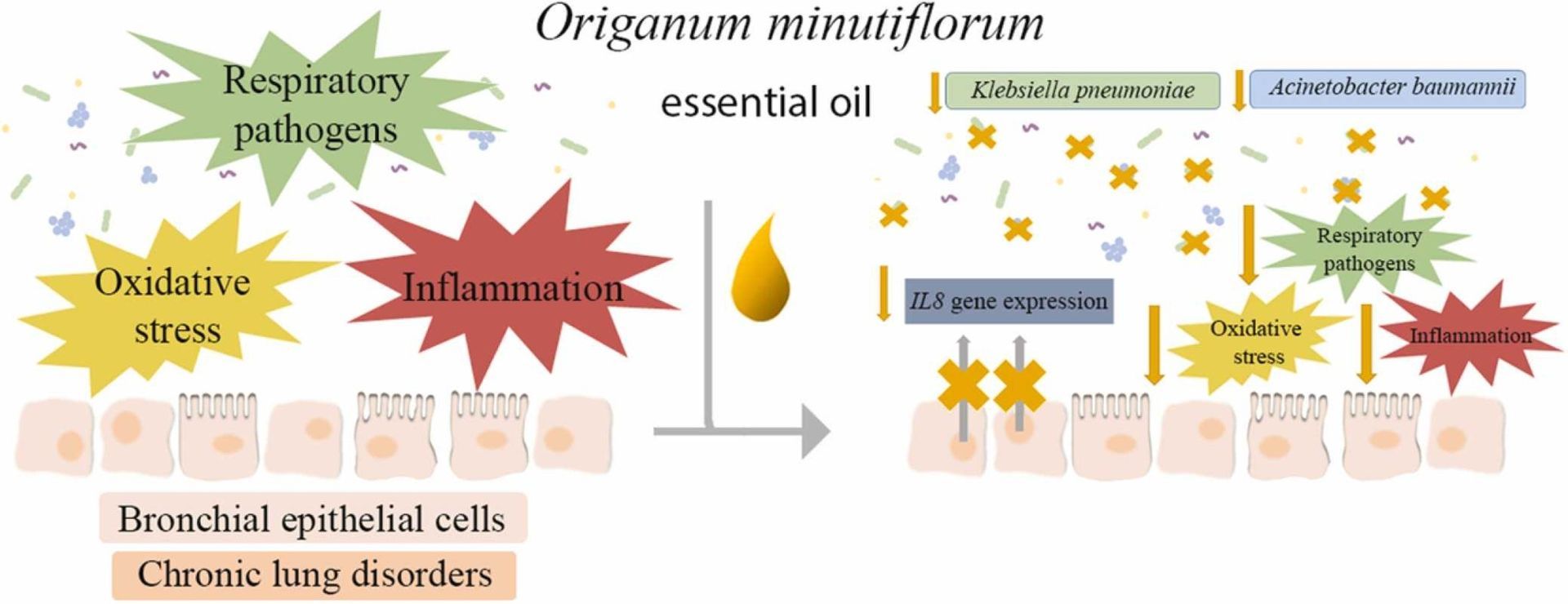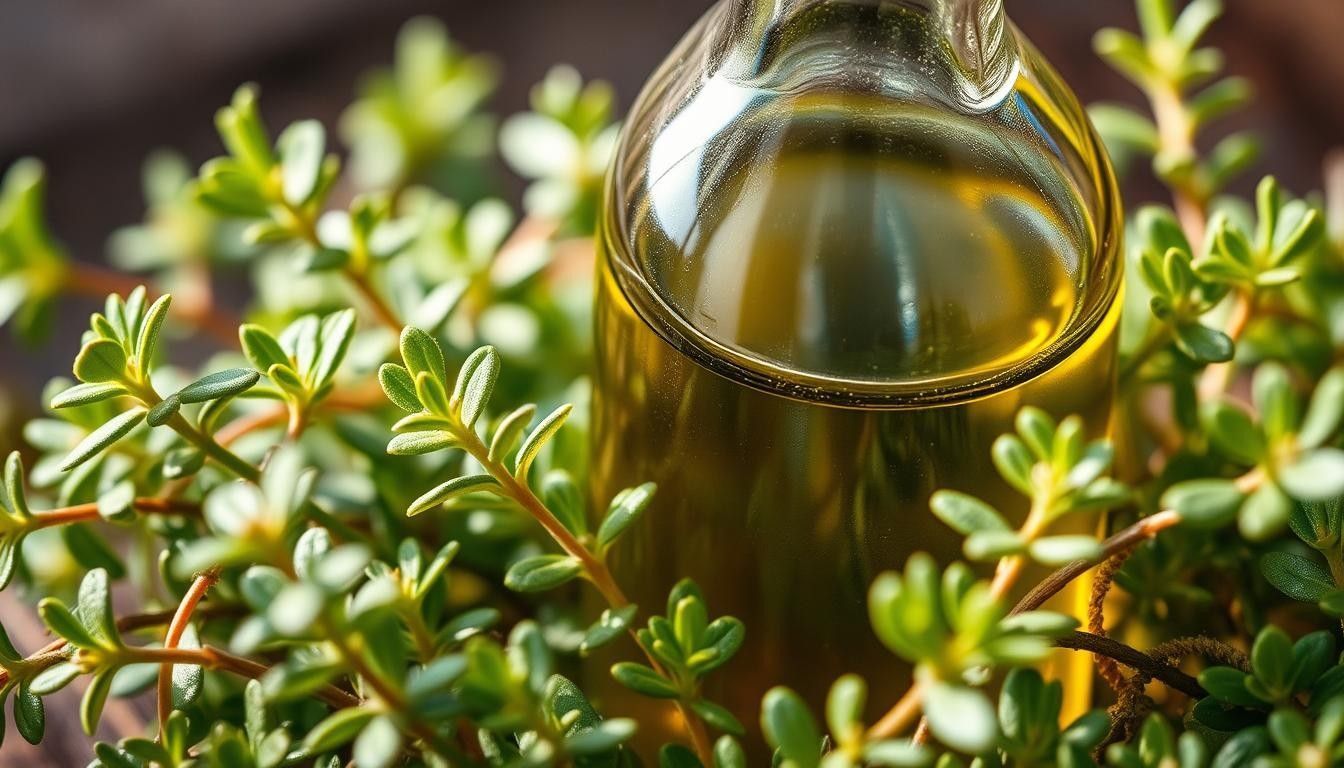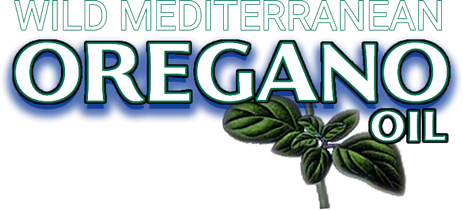Essential oil of Origanum minutiflorum exhibits anti-inflammatory and antioxidative effects in human bronchial cells and antimicrobial activity on lung pathogens
Oregano essential oil (OEO) is one of the most widely used essential oils worldwide due to its huge therapeutic benefits.
Nevertheless, data on the effects of the endemic species Origanum minutiflorum, also known as wild or Turkish oregano, is scarce. On the other hand, various chronic lung diseases, characterised by persistent inflammation, oxidative stress, and common bacterial infections, do not have effective pharmacological therapy. Hence, the aim of this study is to examine the effects of wild oregano essential oil (WOEO) on human bronchial epithelial cells and lung pathogens.

The genus Origanum encompasses important medicinal and aromatic plants which have been used over the years for their exclusive culinary and therapeutic properties. Origanum species is widely distributed around the Mediterranean, North African, Euro-Siberian, and Iran-Siberian regions (Ali et al., 2020, Bayramoglu et al., 2008). Origanum plants are extensively used in everyday life as a well-known spice for cooking, but they are also exploited in the food industry and used in alcoholic beverages and soft drink aromas (Sharifi-Rad et al., 2021).
Origanum species have been traditionally used as a medicinal plant worldwide. The most commonly studied oregano species is Origanum vulgare L. Numerous studies of oregano essential oils (OEO), deriving from various Origanum species, have shown its therapeutic effects in vitro and in vivo (Cheng et al., 2018, Zou et al., 2016; Han et al., 2017). OEO is an appreciated component in modern phytotherapy due to its antimicrobial, anti-inflammatory, antioxidant, antitumor, antimutagenic, and hepatoprotective properties (Lombrea et al., 2020, Sharifi-Rad et al., 2021). The ethnopharmacological uses of OEO comprise treatment of digestive, respiratory, and dermatological disorders (Lombrea et al., 2020). Essential oils of Origanum sp. have been reported to contain carvacrol, linalool, borneol, terpinen-4-ol, thymol, p-cymene, and γ-terpinene (Baser, 2002, Demirci et al., 2004, Ozel and Kaymaz, 2004). OEO has potent biological activities, which are primarily attributed to the presence of carvacrol, thymol, and monoterpenes (Sharifi-Rad et al., 2021). It has been suggested that OEO exerts its effects by modulating signalling pathways involved in inflammation, tissue remodelling, and cancer. Previous studies have demonstrated anticancer properties of OEO by reducing tissue remodelling biomarkers, cell proliferation, cell migration and colony formation, and by inducing apoptosis. A number of studies have reported the anti-inflammatory and antioxidative properties of OEO, including the reduction of proinflammatory cytokine and chemokine levels, inhibition of mitogen-activated protein kinases (MAPK) and reactive oxygen species (ROS) production, and an increase of superoxide dismutase and catalase activity (Sharifi-Rad et al., 2021). The antimicrobial activities of carvacrol and thymol, as the most abundant components of oregano oil, have been widely studied (Rostro-Alanis et al., 2019, Barbosa et al., 2020). Specifically, carvacrol has extensively been tested as an antimicrobial agent in food for the control of Gram-positive and Gram-negative pathogens, such as Bacillus cereus, Enterococcus faecalis, Listeria monocytogenes, Staphylococcus aureus, Escherichia coli O157:H7, Pseudomonas fluorescens, Salmonella typhimurium, and so-forth (Magi et al., 2015). The antibacterial effects of carvacrol are mainly based on its ability to disrupt bacterial membrane (Magi et al., 2015). Carvacrol easily penetrates through the cell membrane of bacteria, leading to disruption of cell membrane integrity and the release of bacterial cell content (Khan et al., 2017). Chauhan and Kang (2014) showed that thymol, an isomer of carvacrol, was able to disrupt bacterial plasma membrane and cause the release of cellular content. However, the effects of OEO from various species vary due to differences in the chemical composition of the essential oil, which is influenced by numerous factors, such as environmental and climatic conditions (Alkan, 2020). Carvacrol is the major component in the essential oils of O. onites (57.0 %), O. minutiflorum (52.0 %), and O. vulgare (59.9 %). However, carvacrol was not the dominant compound in the essential oil of O. syriacum (3.2 %), and it was not detected in the essential oil of O. majorana (Arslan and Dervis, 2010).
O. minutiflorum O.Schwarz & P.H.Davis is an endemic species, also known as wild or Turkish oregano, with scarcely explored biological effects. Studies on O. minutiflorum have shown its antioxidative effects in cell-free systems, and antibacterial, insecticidal, and anticancer effects in vitro (Elmastas et al., 2018, Oke and Aslim, 2010, Sokmen et al., 2020, Dorman et al., 2004, Arserim et al., 2021, Evrendilek, 2015, Cetin et al., 2009, Cetin and Yanikoglu, 2006). The oil content of wild oregano has been investigated by different authors and most studies have demonstrated that carvacrol was found to be the major constituent (42–84 %). The other major constituents were p-cymene, γ-terpinene, borneol, with their quantities raging between 4.3–8.1 %, 1.7–5.1 %, 0.3–5.3 %, respectively (Kirimer et al., 1995, Dadalioğlu and Evrendilek, 2004, Spyridopoulou et al., 2019).
Various chronic lung diseases such as chronic obstructive pulmonary disease (COPD), asthma, cystic fibrosis, and pulmonary fibrosis, although different have some common features. These include activated immune and structural cells that produce pro-inflammatory mediators and oxidative stress leading to excessive and self-perpetuating airway inflammation and tissue destruction (Grondona et al., 2014, Yang et al., 2018, Roesch et al., 2018, Desai et al., 2018). Increased oxidative stress causes chronic lung inflammation, disease progression, and acute exacerbations, which are associated with significant morbidity and mortality (Barnes, 2020a, Barnes, 2020b). In addition, common bacterial colonization of the lower respiratory tract in patients with chronic lung diseases is responsible for a lung inflammatory response leading to exacerbation of the disease (Grondona et al., 2014). Currently, there are no effective disease modifying therapies for many chronic lung diseases and there is an urgent need for the development of novel approaches, which concurrently target inflammation, oxidative stress, and bacterial infection in the lungs (Barnes, 2013, Barnes, 2020a, Barnes, 2020b, Cantin et al., 2015).
In this study, the chemical composition of commercially available wild oregano essential oil (WOEO), O. minutiflorum (Probotanic), was determined by gas chromatography-mass spectrometry (GC-MS) and gas chromatography-flame ionization detector (GC-FID) analysis. Anti-inflammatory effects of WOEO were tested in human bronchial epithelial cells by measuring the expression and production of interleukin 8 (IL8)/chemokine 8 (CXCL8), as one of the primary pro-inflammatory chemokines implicated in inflammation and acute exacerbation in chronic inflammatory lung diseases (Barnes et al., 2003). Moreover, the antioxidative properties of WOEO were analysed by measuring the level of intracellular oxidative stress in human bronchial epithelial cells. Also, the antibacterial effects of WOEO were tested on two lung pathogenic bacteria, Acinetobacter baumannii and Klebsiella pneumoniae.
Methods
We provided a detailed chemical composition of WOEO using GC-MS and GC-FID analysis. Anti-inflammatory effects of WOEO were analysed using the qRT-PCR and ELISA methods, while antioxidative properties were examined by using the dichlorofluorescein assay in BEAS-2B cells. Antibacterial activity was tested on lung pathogens by using the agar diffusion assay.
Results
The major constituents of WOEO, analysed in this study, were carvacrol, linalool, p-cymene, γ-terpinene, and (E)-caryophyllene. We found that treatment with WOEO attenuated LPS-induced IL8 gene expression and hydrogen peroxide-induced oxidative stress in BEAS-2B cells. Moreover, WOEO showed an inhibitory effect on pathogenic bacteria Acinetobacter baumannii and highly resistant Klebsiella pneumoniae commonly seen in healthcare-associated pneumonia.
Conclusion
Our work presents new insights into the anti-inflammatory, antioxidative, and antimicrobial properties of WOEO which may be used as a simple and local treatment in various chronic lung diseases.



